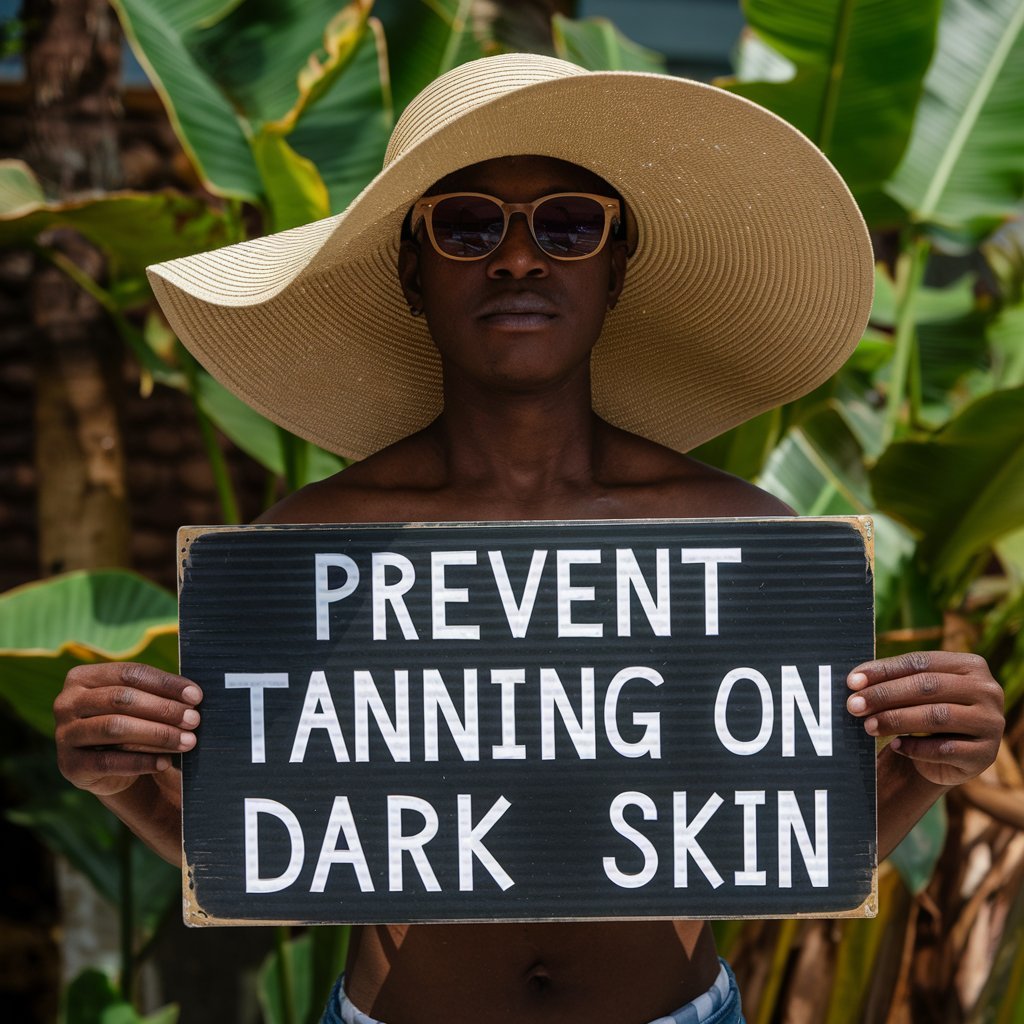How to Prevent Tanning on Dark Skin and Protect It from the Sun

Darker skin tones are beautiful and naturally resilient, but UV rays can still cause sunburn, uneven tone, and stubborn tans. While melanin may delay visible damage, everyone’s skin needs protection from repeated sun exposure.
A daily routine—like wearing sunscreen and covering up during peak sun hours—can help maintain an even glow and reduce long-term risks. For more persistent concerns, professional treatments can address tan lines or stubborn spots. Healthy skin requires a balance of home care and expert guidance.
This blog will explore how to protect darker complexions from sun damage, with tips on shielding your face and reducing tans to keep your skin vibrant and smooth.
Understanding Dark Sink and the Effects of Sun
Dark sink may sound odd, but it highlights how skin with more melanin can still absorb a lot of sunlight. When that happens, tanning and other effects of sun exposure can appear. Without proper care, spots and dull patches might linger. Many people think that darker tones face fewer issues, but that is not always true. Repeated sun exposure can speed up aging, reduce elasticity, and deepen hyperpigmentation. Learning why this happens is the first step to preventing more harm.
How to Prevent Tanning Dark Skin Matters
When we talk about how to prevent tanning dark skin, it is vital to remember that melanin itself is not a perfect shield. Continuous exposure to ultraviolet rays can break down the skin’s protective barrier. This can leave it prone to dryness, uneven spots, and a dull look. By reducing unnecessary tanning, you ensure your skin stays soft and uniform.
Dark Tonner Confusions and Skin from Sun Damage
Dark tonner can be misunderstood. Some believe it can mask deeper sun damage on darker skin, but true damage might still lurk beneath the surface. UV rays can weaken collagen and cause fine lines. Early steps to protect your skin from sun damage, like wearing hats or using broad-spectrum sunscreen, make a big impact.
Tips to Prevent Early Signs of UV Harm
Creating a routine is key. Simple tips to prevent issues include cleansing and moisturizing daily and then applying sunscreen. Reapply if you are outside for hours. Sit in the shade during midday. Consistency makes a noticeable difference. Also, be aware of reflections from water or glass, since they can amplify UV effects.
Avoid Sun Tanning and Protect Your Skin From More Harm
Many folks overlook the power of prevention. If you avoid sun tanning where possible, you can stop hyperpigmentation before it starts. Protective clothing, such as light, long-sleeved shirts or UV-filter umbrellas, helps block direct sunlight. Even small changes, like wearing sunglasses and applying lip balm with SPF, matter. These steps can save you from deeper worries, like stubborn spots or long-term texture changes.

Sunscreen Prevent Tanning for All Tones
Some people think sunscreen prevent tanning only for fair skin, but that is incorrect. Broad-spectrum products protect deeper skin tones from both UVB and UVA rays. Look for a formula that blends well and does not leave residue. Apply it to all exposed areas, not just your face. This is one of the simplest ways to keep your skin healthy.
Sun Protection Factor and How It Helps
Sun protection factor is something we see on every sunscreen label. A higher SPF means better shielding from UVB rays. But you should also look for protection against UVA. Both can harm your skin. A product labeled broad-spectrum is ideal, and reapplication should happen every few hours if you stay outside.
Ways to Reduce Tan and Prevent Sun Tan
Besides sunscreen, there are other methods to reduce tan or prevent sun tan entirely. Use a wide-brimmed hat to block direct rays. If you drive often, consider UV-protective films on windows. Keep track of how long you stay outdoors. Small efforts add up, especially when combined with a healthy skincare routine. For the body, body de-tan methods like using exfoliating scrubs or natural ingredients like turmeric or lemon can also be effective in gradually fading tan from larger areas.
How to Remove Tan and Tan From Your Face Safely
If tanning has already happened, there are gentle ways to remove tan over time. Avoid scrubbing too harshly, since that can lead to irritation or more discoloration. Instead, focus on soft exfoliation and consistent use of products designed for darker complexions. Patience is key, because aggressive efforts might cause even more issues. You want to lighten the tan gradually while keeping your skin barrier intact.
Dark Skin Care with Reliable Methods
For darker shades, reliable methods include mild chemical exfoliants, such as lactic or mandelic acid, which gently lift dead cells. A moisturizer with niacinamide can brighten dull areas. Spot treatments with ingredients like vitamin C or kojic acid can help fade stubborn patches. Tan removal for sensitive skin requires careful product selection to avoid harsh reactions, so always follow with sunscreen in the morning.
Professional Steps to Remove Sun Tan Dark Skin
Sometimes, home care alone is not enough. Dermatologists can suggest peels or laser treatments meant to remove sun tan and dark skin. These options work by targeting specific pigmentation without harming healthy tissue. Experts know how to tailor settings for various skin tones, lowering the risk of irritation and helping you achieve a more even complexion.
Protect Your Skin from Sun with Routine Maintenance
Long-term maintenance is crucial. Keep using sunscreen, even if you are mostly indoors. Moisturize daily to support the skin barrier. Add antioxidants to your regimen to keep free radicals in check. Track changes in your skin, and do not wait to treat new spots. Early intervention can prevent bigger problems down the road.

Best Practices to Avoid Dark Tonner Buildup
Dark tonner is sometimes sold as a quick fix. Yet if it is not used wisely, it can hide early signs of sun damage or uneven tone. Instead, focus on healthy skin practices that let your real complexion shine. Cleanse, hydrate, and use products that address specific concerns without clogging pores. A balanced approach keeps your skin breathing while still looking polished.
Tips to Prevent Harsh Sunlight Exposure
Harsh sunlight can be intense around midday. Schedule outdoor chores or exercise earlier in the morning or later in the day. Wear lightweight, tightly woven fabrics to block UV rays. Keep an eye on the UV index in your area, which can guide when to stay indoors. These actions help keep your natural glow intact.
Effects of Sun on Different Skin Shades
The effects of sun can differ across skin types, but all shades feel its impact. Darker skin might tan slower yet still develop rough texture, dryness, or stubborn spots. Fair skin often shows redness or burns more quickly. No matter our skin tone, we all benefit from mindful steps to block harmful rays.
Keep Your Face Fresh with Protective Habits
A fresh face requires steady control of sun exposure. A mild daily cleanser removes sweat and sunscreen buildup. Follow with a gentle toner or serum, then seal in moisture. Sunscreen is your final layer each morning. Repeat these steps, and your skin stays calmer, more hydrated, and better prepared to fend off UV damage.
Sun Protection Tips for a Lasting Glow
A long-lasting glow comes from simple sun protection tips practiced all year. Even on cooler, cloudy days, UV rays can still reach you. Make sunscreen a habit, not a chore. Hydrate from inside by drinking enough water. Sleep is important too, because your skin regenerates at night. Over time, these small actions create a stronger, healthier foundation.
Everyday Tips for Shielding Your Skin from Sun Damage
Protecting your skin from sun damage begins with daily awareness. Keep an SPF lip balm on you. If your work setting has windows, close blinds or apply UV-protective film. Carry a sunscreen that is easy to reapply. Do not wait for the weekend or a special event. Consistency separates temporary effort from lasting results.
Building a Routine with Dark Sink Awareness
Dark sink awareness means realizing that melanin-rich skin can absorb more sunlight without quick burning, but tanning still occurs. To reduce that tan, layer a vitamin C serum under your sunscreen. Use at-home masks with turmeric or yogurt to brighten them gently. Watch for changes in texture or tone, and adjust your routine as needed.
Final Words: Your Steps to a Healthy Complexion
Seek professional advice if stubborn spots or discoloration persist. Dermatologists understand how to tailor treatments for diverse skin tones. A short visit could offer personalized solutions to keep your skin looking its best. Stay motivated to protect your skin from daily challenges. The reward is a complexion that feels strong, balanced, and vibrant.
Avoiding sun tanning and maintaining an even skin tone requires consistent habits. From choosing the right sunscreen to spending time in the shade, each step helps prevent tan buildup. Don’t forget to cleanse, moisturize, and pay attention to areas prone to discoloration, like the forehead and cheeks.
Investing in your skin leads to fewer spots, a brighter tone, and smoother texture. While darker skin is more resilient, it’s still vulnerable to UV damage. By preventing overexposure and addressing early signs of damage, you’ll build long-term confidence. For advanced methods like chemical peels or laser treatments, consult a specialist experienced with darker skin tones. With professional guidance and your ongoing efforts, you can maintain your natural radiance year-round.

Dr. Sheena Majella is a certified dermatologist and the leading skin specialist at Tune Aesthetics. With a deep passion for skin health and beauty, she combines medical expertise with advanced aesthetic treatments to help clients look and feel their best.





